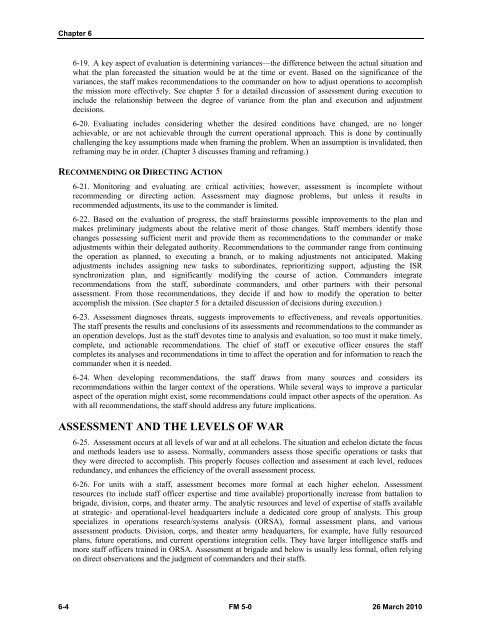FM 5-0, The Operations Process - Federation of American Scientists
FM 5-0, The Operations Process - Federation of American Scientists
FM 5-0, The Operations Process - Federation of American Scientists
Create successful ePaper yourself
Turn your PDF publications into a flip-book with our unique Google optimized e-Paper software.
Chapter 6<br />
6-19. A key aspect <strong>of</strong> evaluation is determining variances—the difference between the actual situation and<br />
what the plan forecasted the situation would be at the time or event. Based on the significance <strong>of</strong> the<br />
variances, the staff makes recommendations to the commander on how to adjust operations to accomplish<br />
the mission more effectively. See chapter 5 for a detailed discussion <strong>of</strong> assessment during execution to<br />
include the relationship between the degree <strong>of</strong> variance from the plan and execution and adjustment<br />
decisions.<br />
6-20. Evaluating includes considering whether the desired conditions have changed, are no longer<br />
achievable, or are not achievable through the current operational approach. This is done by continually<br />
challenging the key assumptions made when framing the problem. When an assumption is invalidated, then<br />
reframing may be in order. (Chapter 3 discusses framing and reframing.)<br />
RECOMMENDING OR DIRECTING ACTION<br />
6-21. Monitoring and evaluating are critical activities; however, assessment is incomplete without<br />
recommending or directing action. Assessment may diagnose problems, but unless it results in<br />
recommended adjustments, its use to the commander is limited.<br />
6-22. Based on the evaluation <strong>of</strong> progress, the staff brainstorms possible improvements to the plan and<br />
makes preliminary judgments about the relative merit <strong>of</strong> those changes. Staff members identify those<br />
changes possessing sufficient merit and provide them as recommendations to the commander or make<br />
adjustments within their delegated authority. Recommendations to the commander range from continuing<br />
the operation as planned, to executing a branch, or to making adjustments not anticipated. Making<br />
adjustments includes assigning new tasks to subordinates, reprioritizing support, adjusting the ISR<br />
synchronization plan, and significantly modifying the course <strong>of</strong> action. Commanders integrate<br />
recommendations from the staff, subordinate commanders, and other partners with their personal<br />
assessment. From those recommendations, they decide if and how to modify the operation to better<br />
accomplish the mission. (See chapter 5 for a detailed discussion <strong>of</strong> decisions during execution.)<br />
6-23. Assessment diagnoses threats, suggests improvements to effectiveness, and reveals opportunities.<br />
<strong>The</strong> staff presents the results and conclusions <strong>of</strong> its assessments and recommendations to the commander as<br />
an operation develops. Just as the staff devotes time to analysis and evaluation, so too must it make timely,<br />
complete, and actionable recommendations. <strong>The</strong> chief <strong>of</strong> staff or executive <strong>of</strong>ficer ensures the staff<br />
completes its analyses and recommendations in time to affect the operation and for information to reach the<br />
commander when it is needed.<br />
6-24. When developing recommendations, the staff draws from many sources and considers its<br />
recommendations within the larger context <strong>of</strong> the operations. While several ways to improve a particular<br />
aspect <strong>of</strong> the operation might exist, some recommendations could impact other aspects <strong>of</strong> the operation. As<br />
with all recommendations, the staff should address any future implications.<br />
ASSESSMENT AND THE LEVELS OF WAR<br />
6-25. Assessment occurs at all levels <strong>of</strong> war and at all echelons. <strong>The</strong> situation and echelon dictate the focus<br />
and methods leaders use to assess. Normally, commanders assess those specific operations or tasks that<br />
they were directed to accomplish. This properly focuses collection and assessment at each level, reduces<br />
redundancy, and enhances the efficiency <strong>of</strong> the overall assessment process.<br />
6-26. For units with a staff, assessment becomes more formal at each higher echelon. Assessment<br />
resources (to include staff <strong>of</strong>ficer expertise and time available) proportionally increase from battalion to<br />
brigade, division, corps, and theater army. <strong>The</strong> analytic resources and level <strong>of</strong> expertise <strong>of</strong> staffs available<br />
at strategic- and operational-level headquarters include a dedicated core group <strong>of</strong> analysts. This group<br />
specializes in operations research/systems analysis (ORSA), formal assessment plans, and various<br />
assessment products. Division, corps, and theater army headquarters, for example, have fully resourced<br />
plans, future operations, and current operations integration cells. <strong>The</strong>y have larger intelligence staffs and<br />
more staff <strong>of</strong>ficers trained in ORSA. Assessment at brigade and below is usually less formal, <strong>of</strong>ten relying<br />
on direct observations and the judgment <strong>of</strong> commanders and their staffs.<br />
6-4 <strong>FM</strong> 5-0 26 March 2010















